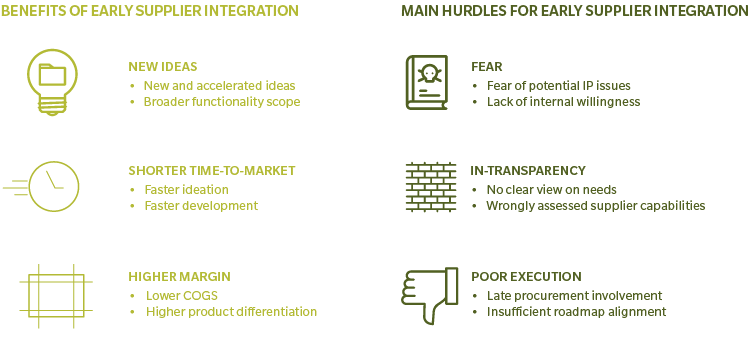Supplier innovation is about leveraging the innovation power of the supply base in a systematic way to increase one’s own innovation performance. If managed successfully, supplier innovation has many benefits including fresh ideas, shorter time-to-market, and higher margins; all of which can lead to profitable growth. Because as much as 70 percent of total lifecycle costs are defined during the design phase, the ability to influence the total cost of ownership decreases rapidly the further out along the development curve you get. But while it seems obvious – the earlier suppliers are integrated, the greater the impact on lifecycle costs can be – managing it is another matter altogether. In a recent study of ours, we found that more than 80 percent of companies struggle with integrating their supplier base into the process and that it often leads to many challenges within the company, ranging from fear about IP issues to lack of transparency about real needs and supplier capabilities to just poor execution. (See Exhibit 1.)
Our study indicates that companies can best address these challenges of integrating suppliers by following three guidelines: clearly prioritize development capabilities for supplier innovation; focus on “profit improvement” instead of pure “cost reduction”; and simplify collaboration with suppliers along the innovation process.
Exhibit 1: Although there are many benefits, it is still not easy to involve suppliers early

Source: Oliver Wyman analysis
CLEARLY PRIORITIZE DEVELOPMENT CAPABILITIES
Pressure to significantly reduce research and development (R&D) costs while concurrently improving innovation performance is almost impossible to achieve. Therefore, it is important to first get your priorities straight: Define core and non-core development capabilities clearly and outsource selected non-core development capabilities to your supply base.
However, simply defining these capabilities is not sufficient. They need to be communicated, both internally to the R&D function and externally to the supply base: internally, to make transparent where suppliers can add value (and to address concerns over potential IP issues and foster a willingness to involve suppliers), and externally, to inform the supply base about the opportunities, so they can make concrete proposals.
Clear agreements are needed for smooth cooperation. In this context, it is not just legal issues on, for example, intellectual capital that has to be addressed, but also reaching consensus on time and quality management. Applying standard processes for intellectual capital management and program management is an effective way to integrate suppliers early in the development process.
FOCUS ON “PROFIT IMPROVEMENT”
The study also reveals that the most important reason for involving suppliers early in the innovation process is “to cover capabilities not available in-house”, closely followed by “shortening time-to-market” and “increasing end-product differentiation”. This clearly underlines, that supplier accordingly, and identify the right suppliers that can support the company in increasing its innovation performance. This means the role of procurement will have to change, as they will need to be involved much earlier in the process and to be proactive in proposing suppliers that can add value.
An important skill in procurement’s new role will be to evaluate a supplier’s innovation performance. It will be necessary for procurement to know suppliers’ areas of innovation, relevant development capabilities, and innovation competencies so as to judge if, how, and what the supplier can contribute to the company’s innovation performance. Moreover, procurement will need to apply new KPIs on supplier innovation performance that go beyond current supplier-relationship-management KPIs.
Over 80% of companies struggle to integrate suppliers early in their innovation process
SIMPLIFY COLLABORATION ALONG THE INNOVATION PROCESS
The tighter suppliers and the company are tied together, the greater the impact of innovation will be. This, however, requires a common understanding of the company’s innovation goals and the areas where suppliers can add value.
The collaboration with suppliers can be simplified by adopting a unified “language” on innovation topics to facilitate communication. Defining the innovation fields the company is active in – and regularly communicating that to suppliers – along with defining how to cooperate effectively and efficiently, are essential to the success of the innovation process.
Given how fast customer requirements change, it is important that the innovation capabilities of your suppliers not remain static. Companies will need to monitor supplier innovation performance on a continuous basis to ensure that they integrate the right suppliers with the right capabilities early in their innovation process.
SUCCESS FACTORS FOR SUPPLIER INNOVATION
Based on our project work across several industries, we have identified five key success factors for getting the most out of supplier innovation:
- Ensure the organizational and cultural readiness of your company to involve suppliers early in the development process
- Clearly define and communicate capability areas for supplier innovation, so procurement and suppliers can act on them
- Identify and attract the best suppliers for future capability areas based on their innovation performance
- Clearly define supplier innovation objectives upfront and aim for long-term “win-win” partnerships
- Ensure cross-functional collaboration along the innovation process, with a driving role for procurement
If managed successfully, supplier innovation will result in new ideas, shorter time-to-market, and higher margins that will support profitable growth.








